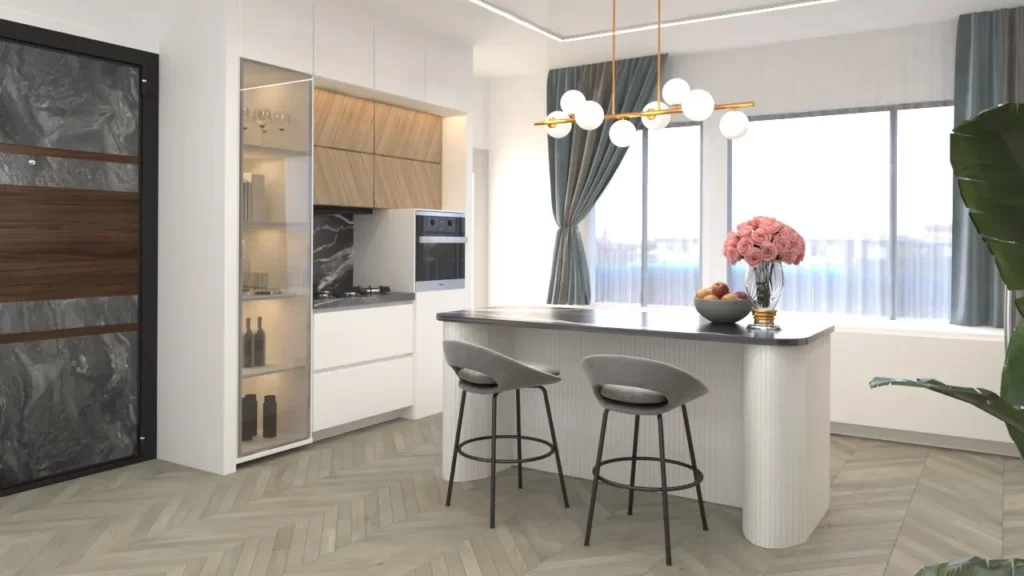Renovation projects represent pivotal moments for homeowners, offering unique opportunities to rejuvenate living spaces, improve functionality, and elevate overall living experiences. At the core of successful renovations lies the intricate blend of art and science known as interior design, transcending mere aesthetics to optimize space, functionality, and sustainability. In this comprehensive exploration, we delve into the multifaceted benefits that interior design bestows upon renovation projects and how it profoundly enriches the lives of homeowners.
-
Maximizing Space Utilization and Efficiency:
Interior design serves as the linchpin for maximizing space utilization within homes. Through meticulous layout planning and thoughtful furniture arrangement, interior designers adeptly transform even the most confined spaces into functional and inviting environments. By ingeniously optimizing storage solutions, crafting multifunctional areas, and harnessing natural light to its fullest potential, interior design ensures that every square foot of space is purposefully utilized, thereby enhancing both practicality and comfort for homeowners.
-
Enhancing Functionality and Flow:
Beyond its aesthetic dimension, interior design is instrumental in enhancing the functionality and flow of living spaces. By closely examining the needs and lifestyle preferences of homeowners, interior designers craft layouts that foster intuitive movement and efficient space utilization. Whether through the seamless integration of open-concept designs to encourage connectivity or the creation of delineated zones that offer privacy and tranquility, interior design harmonizes the flow of energy and activity throughout the home, culminating in a seamless and harmonious living experience.
-
Integrating Sustainable and Eco-Friendly Elements:
In an era marked by heightened environmental consciousness, sustainable design practices have become indispensable to modern renovations. Interior designers play a pivotal role in infusing eco-friendly materials, energy-efficient systems, and sustainable design principles into renovation projects. From conscientiously selecting renewable materials to implementing passive design strategies, interior design not only reduces the ecological footprint of renovations but also fosters healthier indoor environments and mitigates long-term operating costs for homeowners.
-
Personalization and Style Expression:
Among the foremost advantages of interior design is its capacity to authentically reflect the unique personality and stylistic preferences of homeowners. Through close collaboration and keen insight, interior designers curate spaces that resonate deeply with the individual tastes, preferences, and lifestyles of their clients. Whether by infusing spaces with vibrant hues, integrating bespoke furnishings, or weaving in cultural motifs, interior design metamorphoses houses into personalized sanctuaries that evoke feelings of joy, comfort, and belonging.
-
Adding Tangible Value to the Property:
Beyond the immediate enhancements to aesthetics and functionality, interior design exerts a tangible influence on the value of a property. Diligently executed interior renovations have the potential to substantially augment the marketability and resale value of a home. By incorporating premium finishes, contemporary amenities, and timeless design elements, interior design elevates the perceived value of the property, attracting prospective buyers and yielding a noteworthy return on investment for homeowners.
-
Promoting Health and Well-being:
Interior design serves as a cornerstone for promoting the health and well-being of occupants. By integrating elements such as optimal lighting, ventilation, and ergonomic furnishings, interior designers create environments conducive to physical comfort and mental wellness. Furthermore, the incorporation of natural materials and biophilic design principles fosters connections to nature, reduces stress levels, and enhances the overall quality of life for residents.
-
Facilitating Age-in-Place and Universal Design:
As demographics shift and populations age, there arises a growing demand for interior design solutions that accommodate evolving mobility and accessibility requirements. Interior designers employ principles of universal design to fashion spaces that are inclusive and adaptable to individuals of all ages and abilities. Features such as barrier-free layouts, slip-resistant flooring, and strategically placed grab bars seamlessly integrate with the aesthetic of the home while ensuring safety and autonomy for aging homeowners.
-
Enhancing Social Connectivity:
The design of interior spaces can foster social interaction and connectivity among residents. Through deliberate placement of seating arrangements, communal spaces, and gathering areas, interior designers nurture communication, collaboration, and bonding among family members and friends. Whether by creating an inviting living room for intimate gatherings or a convivial kitchen island for lively conversations, interior design fosters meaningful connections and strengthens relationships within the home.
-
Supporting Work-Life Balance:
In an era characterized by the hustle and bustle of modern life, achieving a harmonious balance between work and personal life is paramount. Interior design facilitates the creation of environments that support work-life balance by delineating dedicated workspaces within the home. Whether it entails a home office equipped with ergonomic furnishings and abundant natural light or a serene meditation corner conducive to relaxation and reflection, interior design promotes harmony between professional commitments and personal pursuits, enhancing overall contentment and fulfillment for homeowners.
-
Nurturing Creativity and Inspiration:
A well-designed interior space has the power to ignite creativity and inspire its inhabitants. By incorporating elements of art, culture, and personal interests, interior designers fashion environments that stimulate the senses and spark imagination. Whether it involves a vibrant gallery wall showcasing cherished artworks or a cozy reading nook bathed in natural light, interior design fosters creativity, innovation, and self-expression, enriching the lives of homeowners in profound and meaningful ways.
In summation, interior design serves as an indispensable cornerstone of successful renovation endeavors, enriching living spaces and maximizing benefits for homeowners. From optimizing space utilization and enhancing functionality to integrating sustainable elements and fostering personalization, interior design embodies a holistic approach to creating homes that are not only visually captivating but also functionally robust, environmentally sustainable, and deeply reflective of individual preferences and lifestyles. By harnessing the expertise of seasoned interior designers, homeowners can embark on transformative renovation journeys that breathe new life into their living spaces, foster well-being, and elevate their quality of life for years to come.


